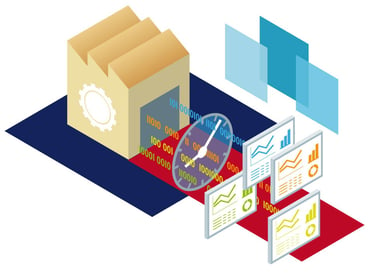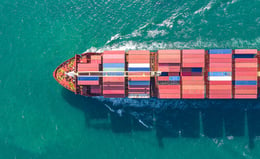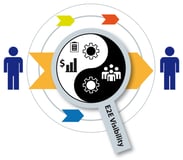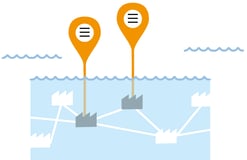5 Ways Increased Visibility Can Help You Scale Your Business
Brian Hoey - July 26, 2018

 Imagine for a moment that you’re planning to do some small renovations to expand your house. They’re straightforward enough that you can do all of the work yourself, but since you have a day job, you can only do the work at night. What’s the first thing you buy? If you answered floodlights, flashlights, or any other light-emitting piece of equipment, then you have the right mentality for success in the modern supply chain. After all, doing work on a house that you can’t see can be dangerous and inefficient. In the same way, trying to grow your business in spite of low visibility can prove not just difficult, but risky. To prove it, here are five way that end-to-end (E2E) supply chain visibility plays an important role in building a smarter, more efficient business.
Imagine for a moment that you’re planning to do some small renovations to expand your house. They’re straightforward enough that you can do all of the work yourself, but since you have a day job, you can only do the work at night. What’s the first thing you buy? If you answered floodlights, flashlights, or any other light-emitting piece of equipment, then you have the right mentality for success in the modern supply chain. After all, doing work on a house that you can’t see can be dangerous and inefficient. In the same way, trying to grow your business in spite of low visibility can prove not just difficult, but risky. To prove it, here are five way that end-to-end (E2E) supply chain visibility plays an important role in building a smarter, more efficient business.
1. Understanding Demand Capacity
Most people, when asked about the circumstances under which they would seek to take on a new customer, will err on the side of taking on all of the business that comes their way. For many operations, however, this type of thinking can lead businesses to overextend their operational capacities, inevitably putting themselves in a situation where some customers will not receive on-time deliveries. Even under these conditions, too much demand might seem like a luxurious problem to have, but many businesses find that this type of demand capacity bottleneck can happen much earlier than anticipated.
The most effective means of staving off this problem is to gain a clear picture of your existing operational capacity (both for planning purposes and so that you can work towards increasing that capacity as needed), but information silos and Shadow IT can make this a difficult and laborious task. By increasing visibility throughout your operation, it’s possible to gain a holistic view of the journey that each product takes through your production stream, including make-time and machine utilization. In this way, you can determine your capacity for taking on new customers with a high degree of precision, essentially optimizing your resource utilization. When these capacity limits begin to seem restrictive, you’ll have enough insight into your production processes to boost that capacity in a thoughtful way.
2. Supply Chain Integration
Not only can visibility help you to determine the maximum number of customers for whom you can successfully provide value, it can also directly increase the amount of value you’re able to provide. Specifically, it can pave the way for effective supply chain integration. In an integrated supply chain, whatever visibility you achieve has a ripple effect across the value chain, meaning that whatever increases in transparency you are able to achieve internally will simultaneously lead to added transparency for your partners or customers and vice versa. Under these conditions, E2E visibility becomes not just an operational luxury, but a key selling point, presenting the possibility of added value for businesses that want to be able to collect data across their entire value chain.
3./4. Empowering S&OE/Smarter Transport Logistics
These next two are related concepts, but sufficiently distinct from one another as to merit separate consideration. The first, sales & operations execution (S&OE), refers to a new, Industry 4.0-specific process that bridges the gap between daily supply chain operations and sales & operations planning (S&OP) workflows. By making small adjustments to transport routing and inventory levels, S&OE planners are able to keep medium-term plans on track and preserve value in the face of potential disruptions. This process requires real-time demand information, and as such a high degree of visibility is required. The payoff for this visibility, however, is increased cohesion between mid- to long-term plans and daily supply chain operations. If your plans including scaling up your business, S&OE can be a critical process for keeping those plans on track.
While S&OE’s purview does include simple transport routing, there is in fact considerable value to be gained from building increased visibility into other elements of your transport logistics, from real-time fuel pricing information to internet of things (IoT) enabled freight sensors that can predict potential damage to goods. By optimizing your delivery and routing processes not just in the face of minor disruptions but with an eye toward shortening lead times and utilizing warehouse and freight capacity in a more efficient way, it’s suddenly possible to handle more volume without risking slowdowns or shortages.
5. Advanced Analytics Integration
This final suggestion is a bit of a catchall, but it’s also an important illustration of the endgame of E2E visibility. Advanced analytics workflows require a significant investment in visibility in order to yield results. Why? Because analytics processes require large quantities of high-quality data in order to produce meaningful prescriptive insights and improved predictive forecasts. If your company’s data is stuck in silos, no amount of technological sophistication will yield positive results. If, on the other hand, your analytics workflows are able to access mission critical information as needed, they can help to improve your various workflows and drive more accurate forecasts, leading to a leaner, smarter, and therefore more scalable business.
LATEST POSTS
- Understand Circular Economy in The Manufacturing Industry
- How Can Industry 4.0 IT Integration Be Achieved Smoothly?
- The Significance of Order Sequencing in Discrete Manufacturing
- How to improve your Supply Chain Management: The Power of Control Towers
- Optimizing Human Resource Scheduling in Manufacturing: A Technological Approach



